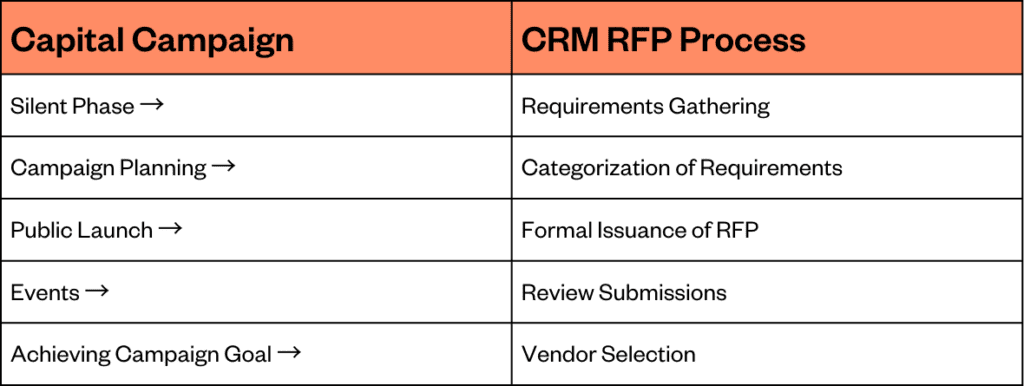
It used to be that education, healthcare, and other nonprofit organizations would change their fundraising system once every 10, 15, or even 20 years. The level of effort required to convert to a new system for a small technical gain was not worth the pain of change management and investment of resources. Now, however, our landscape is different. The technological advances in the last decade make it a no brainer to consider changing systems. The potential benefit is worth the effort.
The decision to update or change your CRM is a big one, though. The impact it can make on your fundraising operations and ultimately, your cause, is huge. However, to be successful, the evaluation process is critical. Enter your RFP.
But how do you create an RFP, and what questions should be included? Read on to find out.
First, let’s outline why an RFP might be necessary
The easy reason is a regulatory requirement. Your institution could require an RFP with a minimum number of responses for the investment that a CRM typically requires. Along that same vein, standardizing vendor selection is important and creates a level field for evaluation—an RFP allows for that standardization. The process ensures that needs are aligned with what vendors can provide. Lastly, the RFP process should mitigate any risks involved in selection, because the RFP process in and of itself is a thorough evaluation.
An RFP is just like a Capital Campaign!
Issuing an RFP is similar to planning for a capital campaign – and can feel as if it’s as much work! The coordination of many moving parts, participation from all parts of the organization, and a healthy timeline are all similar to a capital campaign.
The selection of a new system has a far-reaching impact, just as a capital campaign does. You are selecting a CRM, yes, but you are also selecting the corresponding vendor partner. Our industry is a relationship business, and the relationship with your vendor is just as important as your relationships with your constituents and donors. You’ll want to ensure you know some critical information about the vendor:
- Was the system developed with practitioners who understand your daily work and challenges?
- Does the vendor have practitioners in all areas: product, delivery/implementation, and client support?
- Does the vendor have a robust, responsive support system able to respond to your detailed questions?
- Is the vendor responsive to your feedback and changing needs?
- Is there a mechanism to provide feedback to help inform and prioritize their product roadmap?
- How will the vendor respond to shifting priorities and technological changes?
- Is there a community of other users with which to share information and best practices?

Requirements Gathering (or The Silent Phase)
Requirements gathering is an RFP’s equivilant to the silent phase of a capital campaign. In campaign terms, this is a needs assessment. Involvement from across the organization is imperative in order to articulate the full spectrum of needs and ensure broad-based support and acceptance. A thorough, well articulated set of requirements provides the roadmap for your CRM project.
From vendor selection to scope creation, to user stories in implementation, the requirements you gather from all your stakeholders lay the important groundwork necessary for a successful project. Requirements should articulate the CRM’s ability to fulfill a function necessary. For example, “the CRM should support the ability to have template-based stewardship plans.”
Categorization of Requirements (or Campaign Planning)
Now you move into campaign planning! Once the needs assessment has been completed, then one has the initiatives for which campaign goals and themes can be set. For an RFP, once the requirements have been gathered, you need to compile them into categories. Of course, the requirements provide the basis for evaluation, but there are other pieces of information about the CRM that are critical to the evaluation.
Here are a few categories to include:
- Vendor Questions: (e.g. What is the vendor’s experience in converting from the current legacy system and how many such clients are live?)
- CRM Functionality: (e.g. What functionality isn’t available in the CRM, and needs to be addressed via another vendor or application?)
- Implementation Specifics: (e.g. What is the methodology used for implementation and do client references provide positive reviews?)
- Customer Support: (e.g. Who will pick up the phone to answer your gift processing or advancement reporting questions when you need support?)
Use this cheat sheet for a full list of questions to include in your RFP.
Formal Issuance of the RFP (or the Public Launch)
Just as the creation of the RFP could be considered equivalent to the silent phase of the campaign, the formal issuance of the RFP is akin to the public launch! During this phase, you are publishing the RFP and subsequently engaging with potential vendors by answering questions and providing additional information if required.
Review Submissions (or the “Events”)
Just as there are many post-launch campaign activities and events) to support the overall effort of a capital campaign, after issuing the RFP there are many activities to support selection. Reviews of the vendor submissions and demos are the “events” part of the RFP process. Along the way, you’ll want to compare vendors and score how each fulfills your requirements, which is similar to campaign reporting.
Vendor Selection (or Achieving Campaign Goal)
Finally, at the end of the RFP process, all the scores are tabulated, and a CRM vendor is selected. In campaign terms, that would be when the campaign goals have been met. After the campaign ends, there are activities such as thanking donors and volunteers, a final campaign total announced and a celebration. Likewise, in the RFP process, after a vendor is selected, contract negotiations are conducted and once all parties have signed the contract, a celebration can begin!
The ends justify the means.
Navigating the decision to update or change your CRM system is a critical and strategic endeavor, much like planning and executing a capital campaign. By issuing a well-crafted RFP, you can standardize your vendor selection process, and ensure that the chosen CRM not only meets your functional needs but also becomes a valuable partner in your mission.
Remember that the effort invested in a comprehensive RFP process will pay off in the form of a robust, responsive, and future-proof CRM system. Celebrate the milestones along the way, just as you would in a capital campaign, and look forward to the positive impact this change will have on your fundraising operations and ultimately, your cause!

As the Vice President of Product Evangelism at Kindsight, Caroline Chang is an advancement services expert, with over 30 years of experience in the higher education industry and non-profit fundraising.
Be the first to read our resources.
The world is changing quickly—and our resources help you stay on top of it all. Sign up to get new insights, success stories, and more, sent right to your inbox.



